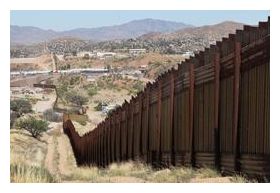
The 1,000 kilometres of impenetrable barrier constructed along the Mexico - United States border, with the aim of stemming illegal human immigration, is also hampering the movements of animals, including several endangered species, a recent study finds.
The species most at risk are those with smaller populations and specialized habitats, says Jesse Lasky, a graduate student at the University of Texas, Austin, and an author on the study, published in Diversity and Distributions.1 Small range size is associated with a higher risk of extinction, and for some species, the barriers reduce range by as much as 75%. According to the study, species most at risk include four listed by the International Union for Conservation of Nature as endangered or threatened - the Arroyo toad (Anaxyrus californicus), the California red-legged frog (Rana draytonii), the black-spotted newt (Notophthalmus meridionalis) and the Pacific pond turtle (Clemmys marmorata) - together with the jaguarundi (Puma yagouaroundi), which is endangered in the United States and threatened in Mexico.
The study also identified three border regions where wildlife is most at risk from the barrier: coastal California, coastal Texas and southeastern Arizona's Madrean Sky Island Archipelago.
Fragmented communities
The Rio Grande Valley, in coastal Texas, contains one of two remaining stands of native Mexican sabal palms. The solid metal and concrete fence, around 5.5 metres high, with an 18-metre-wide strip of open land on either side, runs through a preserve created to protect the trees. Rare animals in the valley include the ocelot, of which fewer than 50 remain in the United States. The fence further fragments their habitat and separates the population in Texas from the larger and more genetically diverse population in northern Mexico.

Sternberg, who monitors the area's bobcat population using cameras and radio collars on around 20 bobcats, says that the border barriers bisected the home ranges of the tracked bobcats. "I tracked some cats for a long time before the wall construction and did see significant shifts in territories," he says. A pair of collared bobcats that lived on the south side of the wall were trapped on the north side, where they were later killed on a highway while searching for new habitat. The presence of this fence-restricted pair may have caused another male bobcat to wander into an urban area - a rare occurrence - where it was killed by a vehicle. Another tracked pair abandoned their home range during construction of the barrier in their area.
Sternberg hopes to collar additional cats to study distribution and movement patterns after barrier construction, but says "I'm afraid most of the previous bobcats are dead due to forced dispersal during construction, so it will be a real challenge to replicate the study in those areas."
Environmental mitigation
The barrier was mandated under the Secure Fence Act, signed into law by George W. Bush in 2006, and Michael Chertoff, the then Secretary of Homeland Security, waived environmental laws for its construction. In January 2009, US Customs and Border Protection (CBP) committed US$50 million to fund mitigation of "unavoidable impacts to natural and cultural resources" from construction of the barriers, to be paid to the Department of the Interior over several years. In September 2010, CBP funded $6.8 million in mitigation projects, but approximately $30 million that was due to be allocated in 2011 was rescinded in the 2011 appropriations bill.
According to CBP spokeswoman Jenny Burke, the agency "remains committed to responsible environmental stewardship", and intends to resume the mitigation projects when funding permits.
The authors of the recent study1 recommend restoring historic connectivity through additional openings or removal of the barrier in key areas. Habitat restoration, particularly in areas where crossings are possible, could also mitigate some effects, Lasky says. "General land-use planning is important. We can plan new development and preserves with an eye to where we can promote connectivity and preserve areas where connectivity exists."
References:
- Lasky, J., Jetz, W. & Keitt, T. H. Diversity Distrib. 17, 673-687 (2011).



Very good article and yes animals migrate and these fences disrupt that important progress of theirs.
However too is the fact and most people don't seem to realize, fences can be used two ways.
To keep people out but also to keep people in (Think the Berlin Wall).
With the Homeland Security, TSA, Scanners and gropers and now with the wall - it seems to me our mobility in America is being covertly curtailed all in the name of safety which is a pile of hooey.
"Today Americans would be outraged if U.N. troops entered Los Angeles to restore order; tomorrow they will be grateful. This is especially true if they were told there was an outside threat from beyond, whether real or promulgated, that threatened our very existence. It is then that all peoples of the world will plead with world leaders to deliver them from this evil. The one thing every man fears is the unknown. When presented with this scenario, individual rights will be willingly relinquished for the guarantee of their well being granted to them by their world government.– Henry Kissinger"
Start researching Henry Kissinger's quotes, this guy in my book is a piece of work and a good example of what Andrew M. Lobaczewski wrote about in his book "Political Ponerology".